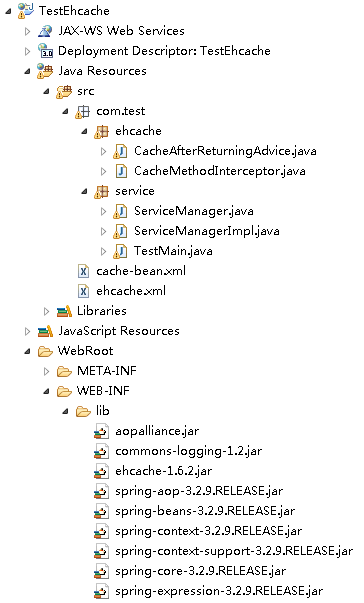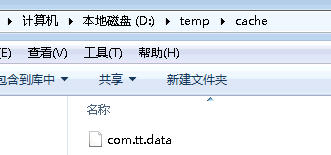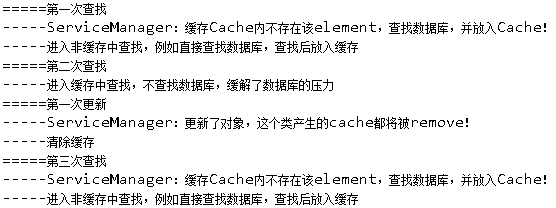來源:Spring搭配Ehcache實(shí)例解析
轉(zhuǎn)自:http://blog.csdn.net/dongdong9223/article/details/50538085
作者:我是干勾魚
1 Ehcache簡(jiǎn)介
EhCache 是一個(gè)純Java的進(jìn)程內(nèi)緩存框架,具有快速、精干等特點(diǎn)朴下,是hibernate中默認(rèn)的CacheProvider耍攘。
Ehcache是一種廣泛使用的開源Java分布式緩存蟀悦。主要面向通用緩存,Java EE和輕量級(jí)容器沟于。它具有內(nèi)存和磁盤存儲(chǔ)噪窘,緩存加載器,緩存擴(kuò)展,緩存異常處理程序,一個(gè)gzip緩存servlet過濾器,支持REST和SOAP api等特點(diǎn)啊掏。
Ehcache最初是由Greg Luck于2003年開始開發(fā)蠢络。2009年,該項(xiàng)目被Terracotta購(gòu)買。軟件仍然是開源,但一些新的主要功能(例如迟蜜,快速可重啟性之間的一致性的)只能在商業(yè)產(chǎn)品中使用刹孔,例如Enterprise EHCache and BigMemory。維基媒體Foundationannounced目前使用的就是Ehcache技術(shù)娜睛。
總之Ehcache還是一個(gè)不錯(cuò)的緩存技術(shù)髓霞,我們來看看spring搭配Ehcache是如何實(shí)現(xiàn)的。
2 Spring搭配Ehcache
系統(tǒng)結(jié)果如下:

3 具體配置介紹
有這幾部分的結(jié)合:
- src:java代碼畦戒,包含攔截器方库,調(diào)用接口,測(cè)試類
- src/cache-bean.xml:配置Ehcache障斋,攔截器纵潦,以及測(cè)試類等信息對(duì)應(yīng)的bean
- src/ehcache.xml:Ehcache緩存配置信息
- WebRoot/lib:庫(kù)
4 詳細(xì)內(nèi)容介紹
4.1 src
4.1.1 攔截器
代碼中首先配置了兩個(gè)攔截器:
第一個(gè)攔截器為:
com.test.ehcache.CacheMethodInterceptor
內(nèi)容如下:
package com.test.ehcache;
import java.io.Serializable;
import net.sf.ehcache.Cache;
import net.sf.ehcache.Element;
import org.aopalliance.intercept.MethodInterceptor;
import org.aopalliance.intercept.MethodInvocation;
import org.springframework.beans.factory.InitializingBean;
import org.springframework.util.Assert;
public class CacheMethodInterceptor implements MethodInterceptor,
InitializingBean {
private Cache cache;
public void setCache(Cache cache) {
this.cache = cache;
}
public CacheMethodInterceptor() {
super();
}
/**
* 攔截ServiceManager的方法徐鹤,并查找該結(jié)果是否存在,如果存在就返回cache中的值邀层,
* 否則返敬,返回?cái)?shù)據(jù)庫(kù)查詢結(jié)果,并將查詢結(jié)果放入cache
*/
public Object invoke(MethodInvocation invocation) throws Throwable {
//獲取要攔截的類
String targetName = invocation.getThis().getClass().getName();
//獲取要攔截的類的方法
String methodName = invocation.getMethod().getName();
//獲得要攔截的類的方法的參數(shù)
Object[] arguments = invocation.getArguments();
Object result;
//創(chuàng)建一個(gè)字符串寥院,用來做cache中的key
String cacheKey = getCacheKey(targetName, methodName, arguments);
//從cache中獲取數(shù)據(jù)
Element element = cache.get(cacheKey);
if (element == null) {
//如果cache中沒有數(shù)據(jù)劲赠,則查找非緩存,例如數(shù)據(jù)庫(kù)秸谢,并將查找到的放入cache
result = invocation.proceed();
//生成將存入cache的key和value
element = new Element(cacheKey, (Serializable) result);
System.out.println("-----進(jìn)入非緩存中查找凛澎,例如直接查找數(shù)據(jù)庫(kù),查找后放入緩存");
//將key和value存入cache
cache.put(element);
} else {
//如果cache中有數(shù)據(jù)估蹄,則查找cache
System.out.println("-----進(jìn)入緩存中查找塑煎,不查找數(shù)據(jù)庫(kù),緩解了數(shù)據(jù)庫(kù)的壓力");
}
return element.getValue();
}
/**
* 獲得cache的key的方法臭蚁,cache的key是Cache中一個(gè)Element的唯一標(biāo)識(shí)轧叽,
* 包括包名+類名+方法名,如:com.test.service.TestServiceImpl.getObject
*/
private String getCacheKey(String targetName, String methodName,
Object[] arguments) {
StringBuffer sb = new StringBuffer();
sb.append(targetName).append(".").append(methodName);
if ((arguments != null) && (arguments.length != 0)) {
for (int i = 0; i < arguments.length; i++) {
sb.append(".").append(arguments[i]);
}
}
return sb.toString();
}
/**
* implement InitializingBean刊棕,檢查cache是否為空 70
*/
public void afterPropertiesSet() throws Exception {
Assert.notNull(cache,
"Need a cache. Please use setCache(Cache) create it.");
}
}
CacheMethodInterceptor用來攔截以“get”開頭的方法炭晒,注意這個(gè)攔截器是先攔截,后執(zhí)行原調(diào)用接口甥角。
還有一個(gè)攔截器:
com.test.ehcache.CacheAfterReturningAdvice
具體內(nèi)容:
package com.test.ehcache;
import java.lang.reflect.Method;
import java.util.List;
import net.sf.ehcache.Cache;
import org.springframework.aop.AfterReturningAdvice;
import org.springframework.beans.factory.InitializingBean;
import org.springframework.util.Assert;
public class CacheAfterReturningAdvice implements AfterReturningAdvice,
InitializingBean {
private Cache cache;
public void setCache(Cache cache) {
this.cache = cache;
}
public CacheAfterReturningAdvice() {
super();
}
public void afterReturning(Object arg0, Method arg1, Object[] arg2,
Object arg3) throws Throwable {
String className = arg3.getClass().getName();
List list = cache.getKeys();
for (int i = 0; i < list.size(); i++) {
String cacheKey = String.valueOf(list.get(i));
if (cacheKey.startsWith(className)) {
cache.remove(cacheKey);
System.out.println("-----清除緩存");
}
}
}
public void afterPropertiesSet() throws Exception {
Assert.notNull(cache,
"Need a cache. Please use setCache(Cache) create it.");
}
}
CacheAfterReturningAdvice用來攔截以“update”開頭的方法网严,注意這個(gè)攔截器是先執(zhí)行原調(diào)用接口,后被攔截嗤无。
4.1.2 調(diào)用接口
接口名稱為:
com.test.service.ServiceManager
具體內(nèi)容如下:
package com.test.service;
import java.util.List;
public interface ServiceManager {
public List getObject();
public void updateObject(Object Object);
}
實(shí)現(xiàn)類名稱為:
com.test.service.ServiceManagerImpl
具體內(nèi)容如下:
package com.test.service;
import java.util.ArrayList;
import java.util.List;
public class ServiceManagerImpl implements ServiceManager {
@Override
public List getObject() {
System.out.println("-----ServiceManager:緩存Cache內(nèi)不存在該element震束,查找數(shù)據(jù)庫(kù),并放入Cache当犯!");
return null;
}
@Override
public void updateObject(Object Object) {
System.out.println("-----ServiceManager:更新了對(duì)象垢村,這個(gè)類產(chǎn)生的cache都將被remove!");
}
}
4.1.3 測(cè)試類
測(cè)試類名稱為:
com.test.service.TestMain
具體內(nèi)容為:
package com.test.service;
import org.springframework.context.ApplicationContext;
import org.springframework.context.support.ClassPathXmlApplicationContext;
public class TestMain {
public static void main(String[] args) {
String cacheString = "/cache-bean.xml";
ApplicationContext context = new ClassPathXmlApplicationContext(
cacheString);
//獲取代理工廠proxyFactory生成的bean嚎卫,以便產(chǎn)生攔截效果
ServiceManager testService = (ServiceManager) context.getBean("proxyFactory");
// 第一次查找
System.out.println("=====第一次查找");
testService.getObject();
// 第二次查找
System.out.println("=====第二次查找");
testService.getObject();
// 執(zhí)行update方法(應(yīng)該清除緩存)
System.out.println("=====第一次更新");
testService.updateObject(null);
// 第三次查找
System.out.println("=====第三次查找");
testService.getObject();
}
}
此處要注意嘉栓,獲取bean是通過代理工廠proxyFactory生產(chǎn)的bean,這樣才會(huì)有攔截效果拓诸。
能夠看出來侵佃,在測(cè)試類里面設(shè)置了四次調(diào)用,執(zhí)行順序?yàn)椋?br>
第一次查找
第二次查找
第一次更新
第三次查找
4.2 src/cache-bean.xml##
cache-bean.xml用來配置Ehcache奠支,攔截器馋辈,以及測(cè)試類等信息對(duì)應(yīng)的bean,內(nèi)容如下:
作者:極樂君
鏈接:https://zhuanlan.zhihu.com/p/23883861
來源:知乎
著作權(quán)歸作者所有倍谜。商業(yè)轉(zhuǎn)載請(qǐng)聯(lián)系作者獲得授權(quán)迈螟,非商業(yè)轉(zhuǎn)載請(qǐng)注明出處叉抡。
<?xml version="1.0" encoding="UTF-8"?>
<!DOCTYPE beans PUBLIC "-//SPRING//DTD BEAN//EN"
"http://www.springframework.org/dtd/spring-beans.dtd">
<beans>
<!-- 引用ehCache 的配置-->
<bean id="defaultCacheManager"
class="org.springframework.cache.ehcache.EhCacheManagerFactoryBean">
<property name="configLocation">
<value>ehcache.xml<alue>
</property>
</bean>
<!-- 定義ehCache的工廠,并設(shè)置所使用的Cache的name答毫,即“com.tt” -->
<bean id="ehCache" class="org.springframework.cache.ehcache.EhCacheFactoryBean">
<property name="cacheManager">
<ref local="defaultCacheManager" />
</property>
<!-- Cache的名稱 -->
<property name="cacheName">
<value>com.tt<alue>
</property>
</bean>
<!-- 創(chuàng)建緩存卜壕、查詢緩存的攔截器 -->
<bean id="cacheMethodInterceptor" class="com.test.ehcache.CacheMethodInterceptor">
<property name="cache">
<ref local="ehCache" />
</property>
</bean>
<!-- 更新緩存、刪除緩存的攔截器 -->
<bean id="cacheAfterReturningAdvice" class="com.test.ehcache.CacheAfterReturningAdvice">
<property name="cache">
<ref local="ehCache" />
</property>
</bean>
<!-- 調(diào)用接口烙常,被攔截的對(duì)象 -->
<bean id="serviceManager" class="com.test.service.ServiceManagerImpl" />
<!-- 插入攔截器,確認(rèn)調(diào)用哪個(gè)攔截器鹤盒,攔截器攔截的方法名特點(diǎn)等蚕脏,此處調(diào)用攔截器com.test.ehcache.CacheMethodInterceptor -->
<bean id="cachePointCut"
class="org.springframework.aop.support.RegexpMethodPointcutAdvisor">
<!-- 加入切面,切面為當(dāng)執(zhí)行完print方法后侦锯,在執(zhí)行加入的切面 -->
<property name="advice">
<ref local="cacheMethodInterceptor" />
</property>
<property name="patterns">
<list>
<!--
### .表示符合任何單一字元
### +表示符合前一個(gè)字元一次或多次
### *表示符合前一個(gè)字元零次或多次
### \Escape任何Regular expression使用到的符號(hào)
-->
<!-- .*表示前面的前綴(包括包名)驼鞭,意思是表示getObject方法-->
<value>.*get.*<alue>
<st>
</property>
</bean>
<!-- 插入攔截器,確認(rèn)調(diào)用哪個(gè)攔截器尺碰,攔截器攔截的方法名特點(diǎn)等挣棕,此處調(diào)用攔截器com.test.ehcache.CacheAfterReturningAdvice -->
<bean id="cachePointCutAdvice"
class="org.springframework.aop.support.RegexpMethodPointcutAdvisor">
<property name="advice">
<ref local="cacheAfterReturningAdvice" />
</property>
<property name="patterns">
<list>
<!-- .*表示前面的前綴(包括包名),意思是updateObject方法-->
<value>.*update.*<alue>
<st>
</property>
</bean>
<!-- 代理工廠 -->
<bean id="proxyFactory" class="org.springframework.aop.framework.ProxyFactoryBean">
<!-- 說明調(diào)用接口bean名稱 -->
<property name="target">
<ref local="serviceManager" />
</property>
<!-- 說明攔截器bean名稱 -->
<property name="interceptorNames">
<list>
<value>cachePointCut<alue>
<value>cachePointCutAdvice<alue>
</list>
</property>
</bean>
</beans>
各個(gè)bean的內(nèi)容都做了注釋說明亲桥,值得注意的是洛心,不要忘了代理工廠bean。
4.3 src/ehcache.xml
ehcache.xml中存儲(chǔ)Ehcache緩存配置的詳細(xì)信息题篷,內(nèi)容如下:
<?xml version="1.0" encoding="UTF-8"?>
<ehcache xmlns:xsi="http://www.w3.org/2001/XMLSchema-instance" xsi:noNamespaceSchemaLocation="http://ehcache.org/ehcache.xsd">
<!-- 緩存文件位置 -->
<diskStore path="D:\\temp\\cache" />
<defaultCache maxElementsInMemory="1000" eternal="false"
timeToIdleSeconds="120" timeToLiveSeconds="120" overflowToDisk="true" />
<!-- 定義緩存文件信息词身,其中“com.tt”為緩存文件的名字 -->
<cache name="com.tt" maxElementsInMemory="10000" eternal="false"
timeToIdleSeconds="300000" timeToLiveSeconds="600000" overflowToDisk="true" />
</ehcache>
能夠看到緩存的存儲(chǔ)的存儲(chǔ)位置設(shè)置為“D:\temp\cache”,緩存名稱設(shè)置成了“com.tt”番枚,如圖:

4.4 WebRoot/lib
所需的java庫(kù)法严,詳見開頭的系統(tǒng)結(jié)構(gòu)圖片,此處略葫笼。
5 測(cè)試
執(zhí)行測(cè)試類深啤,測(cè)試結(jié)果如下:

通過執(zhí)行結(jié)果我們能夠看出:
第一次查找被攔截后發(fā)現(xiàn)是首次攔截,還沒有緩存Cache路星,所以先執(zhí)行一下原有接口類溯街,得到要查詢的數(shù)據(jù),有可能是通過數(shù)據(jù)庫(kù)查詢得到的洋丐,然后再生成Cache苫幢,并將查詢得到的數(shù)據(jù)放入Cache。
第二次查找被攔截后發(fā)現(xiàn)已經(jīng)存在Cache垫挨,于是不再執(zhí)行原有接口類韩肝,也就是不再查詢數(shù)據(jù)庫(kù)啦,直接通過Cache得到查詢數(shù)據(jù)九榔。當(dāng)然這里只是簡(jiǎn)單打印一下哀峻。然后是第一次更新涡相,被攔截后所做的操作是將Cache中的數(shù)據(jù)全部存入數(shù)據(jù)庫(kù),并將Cache刪除剩蟀。
最后是第三次查詢催蝗,被攔截后又發(fā)現(xiàn)系統(tǒng)不存在Cache,于是執(zhí)行原接口類查詢數(shù)據(jù)庫(kù)育特,創(chuàng)建Cache丙号,并將新查詢得到的數(shù)據(jù)放入Cache。同第一次查詢的方式是一樣的缰冤。
至此我們就實(shí)現(xiàn)了Spring搭配Ehcache所需要完成的操作犬缨。
6 附件源代碼
附件源代碼可以從我的github網(wǎng)站上獲取。
本文完棉浸!